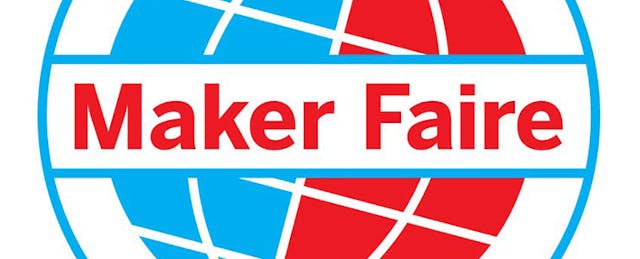Maker Faire is a teacher’s dream come true. The 1-3 day event—which exhibits where students can meet different makers, with hands-on experiences that include tinkering, creating, building and modifying what is already built to make it stronger.
Maintain student engagement in the classroom can be a struggle. It's difficult to find real-world connections to the concepts that we teach, but the Maker Faire is designed to offer experiential learning opportunities.
Many of the exhibits feature student work, providing motivation to young makers. For students, the Maker Faire is a place where wildest dreams can come true. For teachers, the Maker Faire brings learning to life and is the perfect place to inspire creativity in the classroom.

This past Saturday, I boarded the Queens-bound 7 train to the World Maker Faire at the New York Hall of Science with sixth grader Ava. We met fellow middle schoolers Jake and Nicholas, both in seventh grade for a community field trip of sorts. We already knew that the Maker Faire would be a great way to spend a day with friends and family, but what we learned is that it can also provide a unique and exciting field trip experience for both students and teachers.
- Modeling: Modeling is a crucial component of instruction because it is the time when we get to show, rather than tell. Modeling supports understanding and promotes questioning. We headed to the Makerbot exhibit together so that I could model how to explore, experience and ask the right questions. We also practiced viewing machines from multiple perspectives, and note-taking on our reporting sheets. My team observed me and in no-time they were coming up with their own questions, asking for brochures and using their five senses to better understand the printers. That’s when I knew they were ready to tackle exploration with increasing independence!
- Goal-setting: Goal-setting is important, especially on field trips. Upon arrival, Jake and Nicholas were bursting at the seams. “You’ve gotta see the go-carts and the 3D printing over there,” they chimed with excitement as they had already gotten started exploring. I briefed the team on our goals for the day: explore, make, document and have fun! The “document” element can be daunting and usually requires some structure, so the ELA teacher in me decided to bring along these reporting sheets.

- Scatter & Explore: The strongest lessons have an independent or group practice element, during which students have an opportunity to explore a concept or practice a skill with increased independence. After working together to explore and document our findings at the Makerbot exhibit, it was time for students to use their knowledge to explore and document on their own. Throughout the day, our team scattered, explored, built, created and documented with the goal of sharing about the one experience that moved each of us the most. In the end, we came together to share and debrief our top picks of the day.
So what specific activities did we encounter? Here is a look at our day for those of you who are thinking of braving your next local Maker Faire.
Marshmallow Shooters Take the Cake
Jake and Nicholas were ecstatic upon arrival, and their energy didn’t wane the entire day. The exhibits that Jake and Nicholas gravitated to were connected. All three related would have been great stops for a science field trip. Nicholas was amazed by the LED Orbital Rendersphere and excited about the future plan to build a video game, allowing players to build their own planets. Through his questioning, he learned all about persistence of vision. We couldn’t pull Jake away from the Vex Robotics station, where Maker Faire attendees could race their cars and play freeze tag. This would be particularly exciting for schools that have robotics teams or clubs.
In the end, Nicholas and Jake decided that if they had to choose one experience to share, it would be the long awaited Marshmallow Shooters. They couldn’t stop raving about the simple enjoyment they got from building their own marshmallow shooters. They shared, “You can make them at home, you just have to get the PVC tubing. It’s interactive, do it yourself and it shoots food. What could be better?” Sure, it’s enjoyable—but it also would be a fun way for a physics teacher to explore velocity and energy. (Check out this science activity using marshmallow shooters.)
Trailer Park Oasis
The 3D printing section of the faire is a perfect fit for art teachers and students. Ava, who amongst many things is an artist, couldn’t believe the futuristic nature of 3D printing. She fell in love with the way the MakeWithMoto team was using 3D printers to create iPhone cases and jewlery, in particular the tessellation bracelets. But at the end of the day, after visiting tons of booths, exhibits and shows, Ava was most moved by Kim Holleman’s Trailer Park, A Mobile Public Park installation. Here are her thoughts (transcribed from Ava’s reporting sheet). Art and science teachers, you’ll want to read this!
"Trailer Park, A Mobile Public Park: I chose this station because I thought it was the most original. It was a creative idea that turned into a reality. It was really cool how someone could transform a trailer into a park. Kim Holleman is the maker of the park. Her park was made in 2006 and it took her a year because she built it by herself. The park was shown for the first time at the Storefront for Art and Architecture. When you walk into the trailer, you see plants all around you. The floor is made of bricks, and there are two benches which give the park a zen feel, like an oasis. The trailer’s windows are all open, as is the sunroof. Best of all the park is portable." —Ava
"The Trailer Park: A Mobile Public Park" exhibit is be a great stop for art and science teachers. It is an exciting way to reimagine recycled art and every inch of the design is a lesson on sustainability, environment, and even urban planning.
Personally, I was most moved by the way I saw young makers getting involved. Seeing the Maker Faire through the eyes of middle schoolers was enlightening. It made me realize how rarely we get to hear children’s perspectives on important issues in education, like the way learning is approached from both inside and outside of schools. Ava, Jake and Nicholas were engaged throughout the day, and during our debrief, all of them were able to speak about their favorite stops and discuss the learning that happened along the way using new domain-specific vocabulary. Multiple conversations began with, “Hey, I want to make that!”
The concept of making is motivational and promotes students to seek out opportunities for risk-taking, building and learning. Attending a local Maker Fair is important for teachers of all subject areas. And if given the opportunity to turn it into a field trip, I encourage attending with students.


